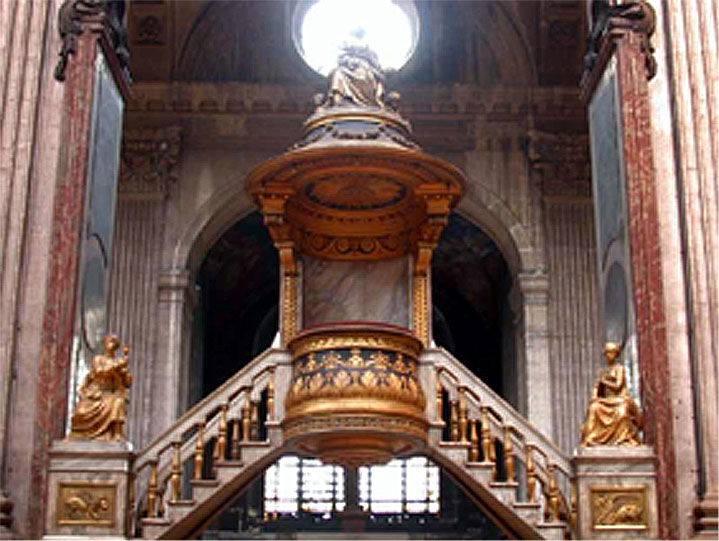by Fr. John A. Peck
Part Three of a Five Part series
A Short History of the Liturgical Location for Preaching: The Ambo, the Pulpit and the Lectern.
The Pulpit

The word pulpit comes from the Latin pulpitum, meaning a stage or scaffold. The most popular and consistent architectural ‘solution’ to a highly visible and clearly audible location in a Church has been the pulpit.
The pulpit is the direct descendant of the ambo, as is an elevated stand to preach on, attached to the Church building itself – often to a pillar. To elucidate the meaning of the word, we can refer to Solomon (2 Chronicles 6:13), who prayed from
“a brazen scaffold,”
and to Esdras (Nehemiah 8:4) who
“stood upon a step of wood”
and read the law of God. Their elevated position and public action suggest to some the symbolical meaning of the pulpit: the level of the perfect. It has been also called the analogium, from the preaching of the word of God.
Originally, the bishop often preached from his cathedra; a survival of this is retained in the French and German words for pulpit, chaire and predigtstuhl. The other German word kanzel recalls the position of the ambo at the choir-screen, or chancel screen (cancelli). The pulpit characterized as part of the church furniture by its independent position and use, found itself separated from the choir and pushed forward in the central part of the nave beyond the choir for singers.
According to Eusebius, Paul of Samosata (Eusebius, 7, 30) spoke to the people from a high canopied seat in the apse.
There can be no doubt that the pulpit, like the ambo, is a very Orthodox piece of liturgical architecture, and not just in the bygone past, but in today’s parish church as well.
Sample Pulpits
Here is a sampling of pulpits from early Christian/Orthodox Churches – as I could find them.
Leading the way of our list of examples of Orthodox pulpits is this first one from the Patriarchal Cathedral of St. George (Ecumenical Patriarchate). Note that it needs no sounding board over the top – it is placed so high on the pillar that it uses the ceiling for that purpose!
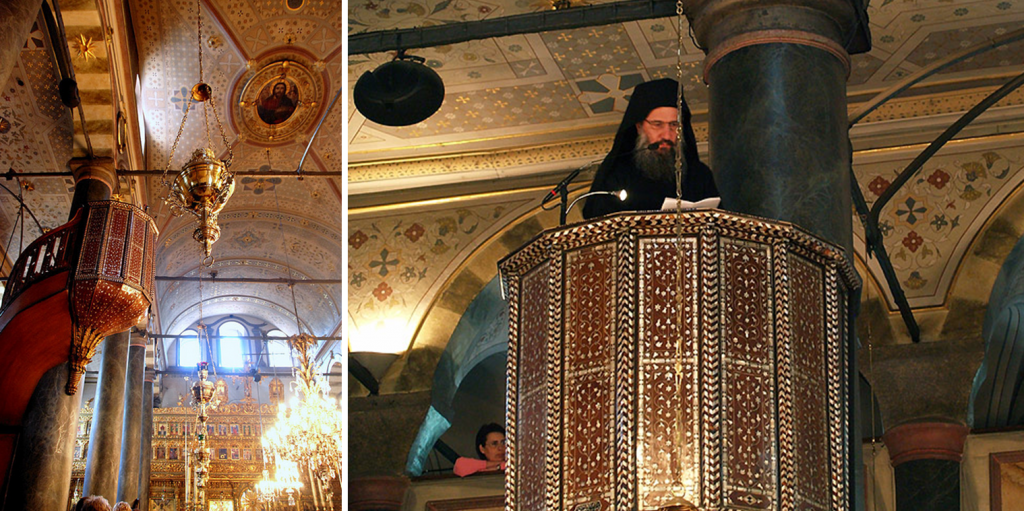

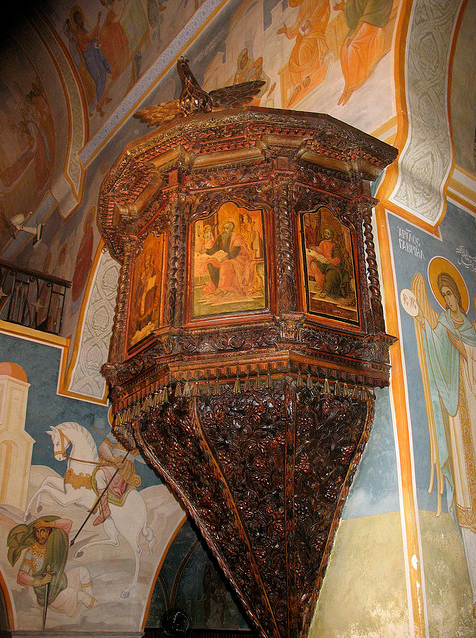
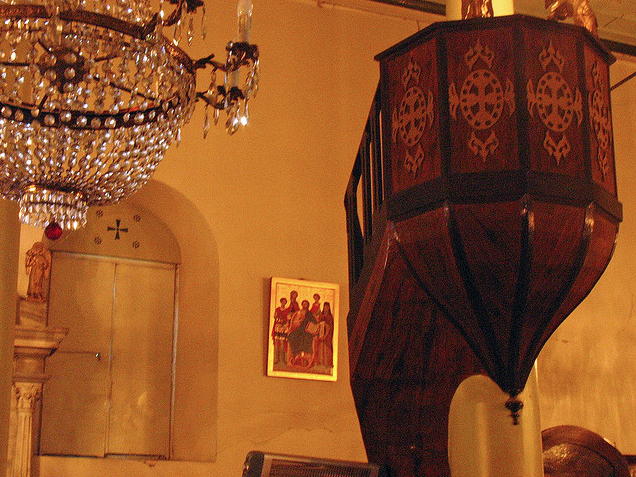
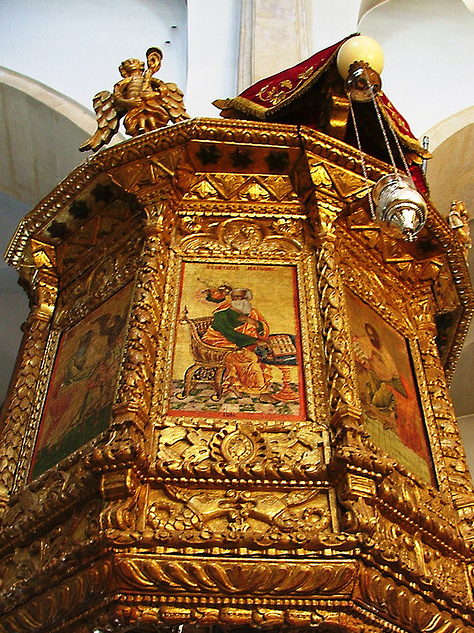
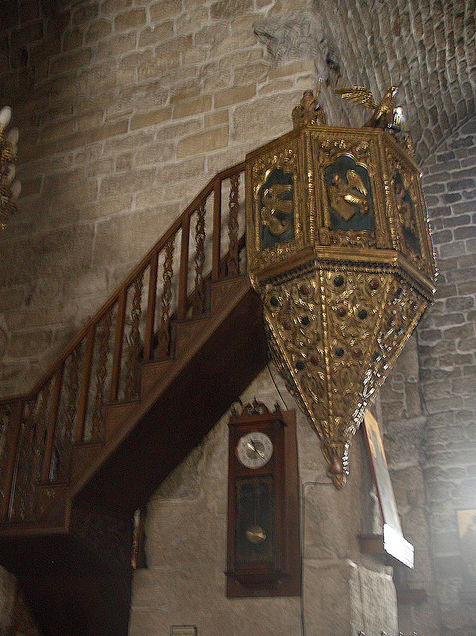
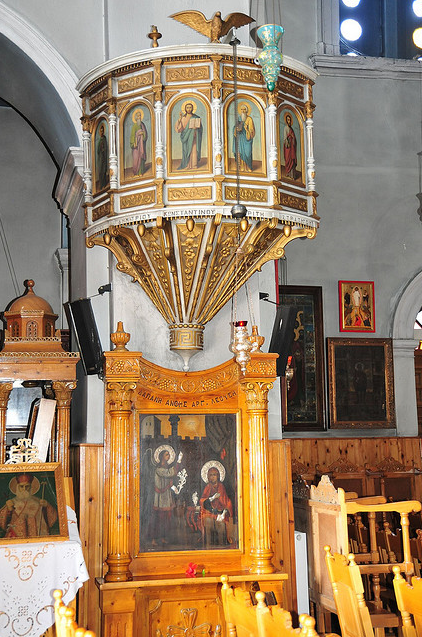
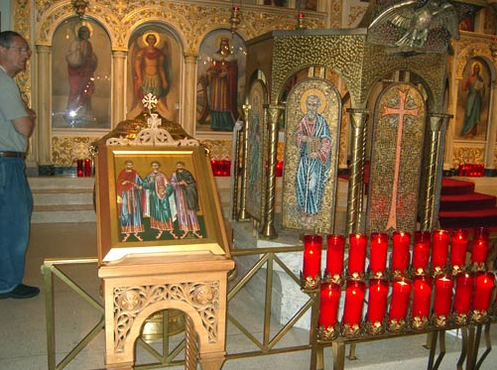
Where the Gospel of Christ is preached in the Orthodox Church, and no ambo is available, there should be a pulpit!
Ornamented Pulpits
Pulpits became a central fixture in Churches in Europe as preaching took its proper place in the liturgical service. Pulpits, like Altars, iconostases, and rails, became more and more ornamented, and were often sponsored by wealthy merchants or royalty, and were appropriately adorned as the location where, again, the most important part of the service of the Word took place.
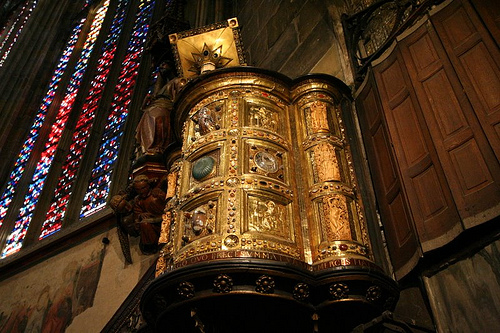
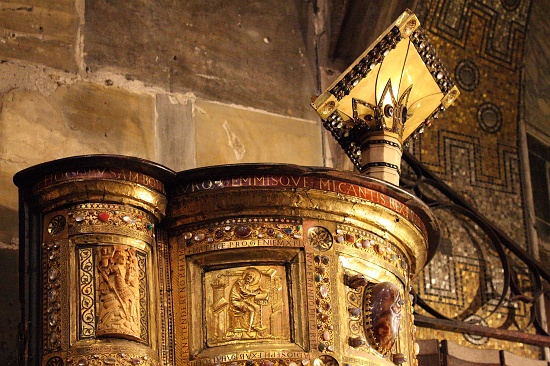
The stunningly beautiful pulpit in the cathedral at Aachen, Germany was, according to the inscription, a present from Emperor Henry II (d. 1024). The ground-plan consists of three unequal segments of a circle. The wooden core is covered with sheets of copper overlaid with gold. Of the fifteen flat surfaces formed by slightly sunken panels, six contain ivory carvings belonging to an earlier period, and the others, precious stones, cups of rock-crystal, and enamels. There is no explanation as to what this was intended to represent: with large generosity the emperor had given whatever he had that was costly for the house of God.
In many places the pulpit was made a part of the rood-loft, which was a gallery or loft of wood or stone, existing as early as the eleventh century and used, instead of the cancelli, to separate the choir from the nave; it was called the lectorium, or odeum, as the loft where the singers were, and doxale from the singing of the doxologies. Statues of the Savior and His Apostles, representing the Last Judgment and the Passion, frequently ornamented the rood-loft on the side towards the nave.
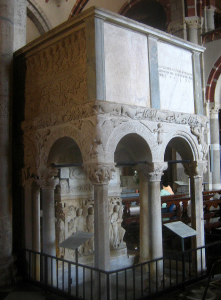
At Wechselburg in Saxony a Romanesque pulpit from the beginning of the thirteenth century is still in existence; it probably belonged, together with the celebrated altar cross, to the partially preserved rood-loft, which, with a few others of that period, is still to be found. It is ornamented with well-executed reliefs, and rests on arcades and columns. In the central oval panel, or mandorla, there is a relief of Christ as teacher, surrounded by the symbols of the Evangelists; on either side are Mary and John trampling upon allegorical symbols of error. The other reliefs, viz., the sacrifices of Abel and Abraham and the Brazen Serpent, were chosen with reference to the cross and altar in the rood-loft, redemption by Christ’s sacrificial death being a main topic of preaching.
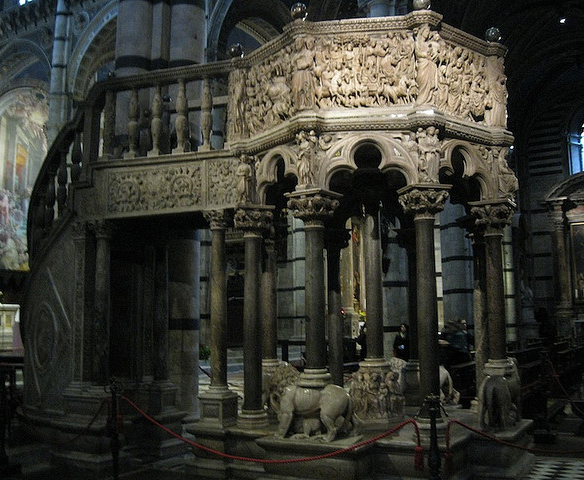
The pulpit at Pisa, completed by Niccola Pisano in 1260, is an unattached structure resting on seven columns, which opened the way to a new development for Italian sculpture. In addition to what is palpably borrowed from antiquity, e.g. the Virgin as Juno, there are figures taken entirely from the life of the time. Instead of the mosaic, six bas-reliefs surround the breastwork: the Annunciation, Nativity, Adoration of the Magi, Presentation in the Temple, Crucifixion, and the Last Judgment; they present the main contents of the doctrine of Salvation.
The first examples of Renaissance pulpits are those of Donatello (fifteenth century). Donatello inserted here into the original round form of the pulpit seven white marble panels, on which in his customary manner he represented in bas-relief little cherubs in an animated dance; the ornamentation of the bronze capital below the pulpit, which rests on a single support, is also purely decorative in character.
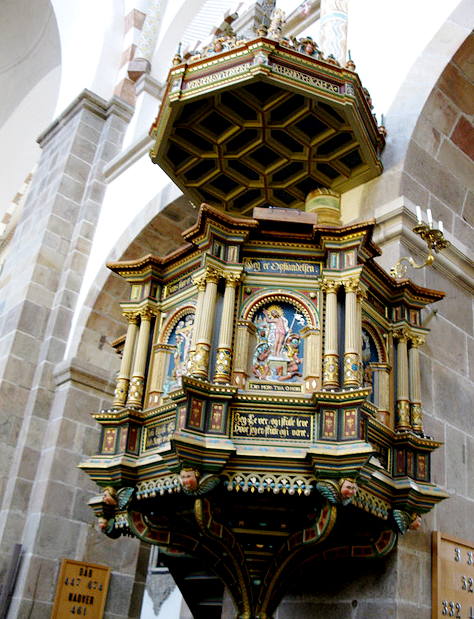
At an earlier era the platform of the pulpit was supported by an understructure or by a number of columns, and during the Renaissance pulpits projected from a pillar or wall, like balconies. Both bronze pulpits in San Lorenzo at Florence rest on four Ionic columns, and are decorated with representations of the Passion, over which there is a frieze of cherubs borrowed from the art of antiquity.

The magnificent pulpit made by Master Pilgram for the Cathedral of St. Stephen at Vienna (sixteenth century) is decorated with busts of the Fathers of the Church and figures of other saints.
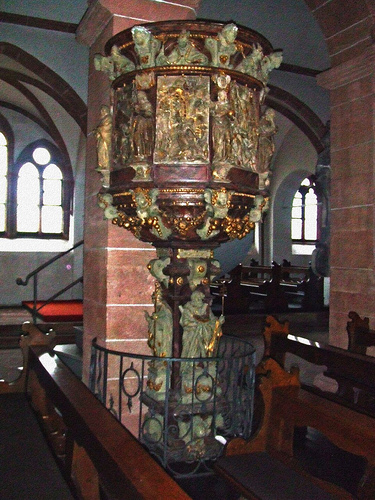
The ornate decoration of the pulpit of the collegiate church at Aschaffenburg depicts the Church Fathers around the supporting pillar, busts of the same in the upper frieze, scenes from the Bible separated by spirited figures of the Evangelists, and angels in the place of consoles. In the Cathedral at Trier the ascent to the pulpit is covered by a magnificently ornamented archway with a high decoration at the top. On the string-piece of the steps are carved the Sermon on the Mount and the Last Judgment, and on the panels of the parapet the works of mercy are depicted.
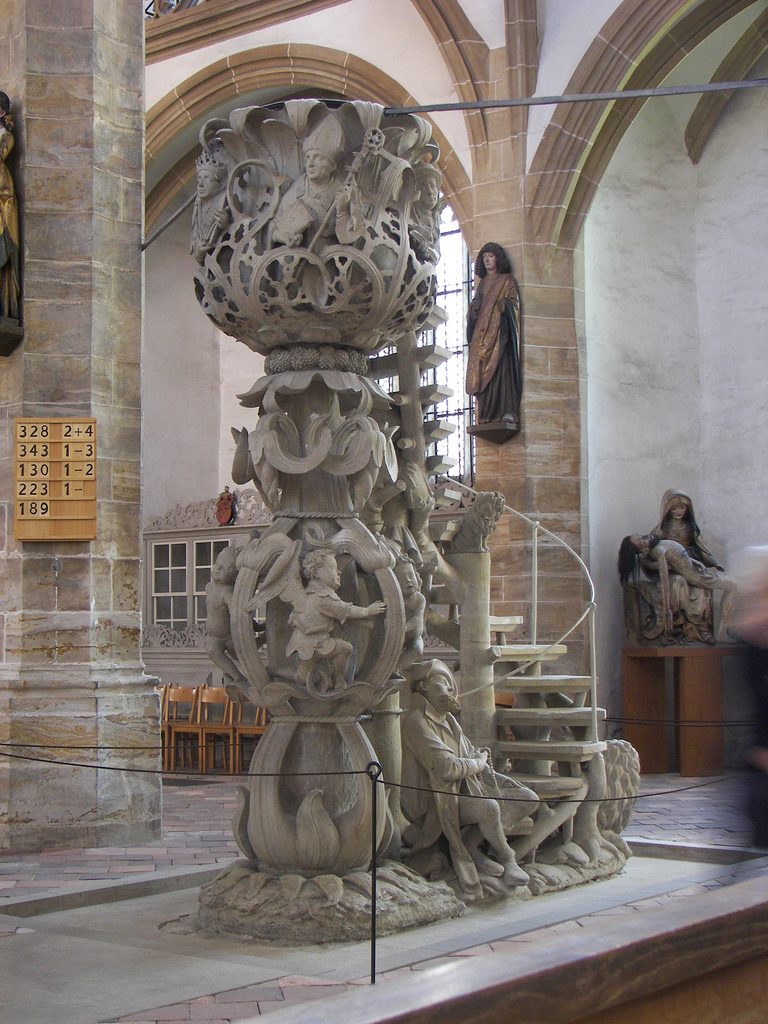
The pulpit of Freiberg in Saxony is fantastically developed from the root of a plant and on it in a naturalistic manner the figures of men and animals are formed.
The most striking pulpits of the Baroque period are those of Belgium. The base, stairway, and sounding-board were artistically or fantastically covered according to the taste of the time with luxurious and ornate carving.
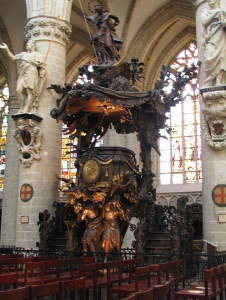
In St. Gudule’s at Brussels the banishment of Adam and Eve from Paradise is carved underneath the pulpit, while, in contrast, the Mother of God is represented above the sounding-board as a mighty female warrior and slayer of the dragon.
Underneath the pulpit of the cathedral at Mechlin there is a representation of the Crucifixion on Calvary with the people at Christ’s feet, while below the rock Saul falls from his horse, overcome by the truth; above at the side are carvings of Adam and Eve with the Serpent. All these are rich in suggestions for the sermon.

At the base of the pulpit of the Church of St. Andrew at Antwerp there is a splendid carving of Christ, and the Apostles Peter and John in a little boat. Over the enormous sounding-board angels hold on high the St. Andrew’s cross, and beneath the dove, representing the Holy Spirit, sends rays in all directions. Note the resemblance in structure of the above pulpit with a classic ambo.
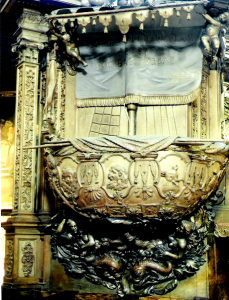
The whole structure of a pulpit in Krakow represents a ship, with sails, mast, and rigging, poised over sea monsters.
Recommended:
Click here to see a collection of 41 pulpits in Finnish Churches
Pulpit Ornamentation: General Principles
The ornamentation of the pulpit should never be excessive, but subordinate to that of the altar, whose view it should not obstruct. The latter difficulty is often removed by setting the pulpit slightly towards the side aisle, whereby a troublesome echo from the transept is avoided. Near which pillar of the nave the pulpit should be placed depends upon the acoustics of the church.
The sounding-board should, above all, make the voice of the preacher perfectly distinct; by giving it, the form of a shell the waves of sound are often sent in a definite direction. In order that the speaker may be readily understood, the pulpit should not stand too high. Its ornamentation should be appropriate: representations of the Evangelists or Church Fathers, scenes from the Bible, as the Sermon on the Mount, the dove as a symbol of the Holy Spirit on the underside of the sounding-board, and perhaps an angel over it. A simple pillar skillfully developed into the platform of the pulpit, is satisfactory, when its decoration and that of the stairway and string-piece is subordinate to that of the central main part. The lack of a vertical support makes an unpleasant impression; a reading-desk or crucifix is apt to produce an overloaded effect.
A well-arranged pulpit-cloth varied in color to suit the various feasts and periods of the year would not be improper.
Does the Pulpit have a place in Orthodoxy Today?
I think the answer to this is rather simple: Obviously yes, but only where preaching the Gospel is important. What is worse than an idle pulpit? That would be rather like having an idle altar – God forbid!
The glaring omission of pulpits in Orthodox Church architecture is not simply a reliance on the Eucharistic portion of the Liturgy, which is always primary in Orthodox architectural planning, but an abandonment of it as a necessary part of the Liturgy of the Word. Preaching in many places has atrophied to the point that sermons are no longer expected, and no longer given. Christian instruction, discipleship and education have been considered a private matter, not a parish one.
The reintroduction of the pulpit to contemporary Orthodox parish churches would be a small expense, and provide a serious challenge to the Church, a challenge to clergy in their sermon preparation and presentation, and a serious challenge to the laity who must, likewise, improve their listening skills in some places – which have atrophied as well.
At the end of this series of articles, I will offer some links to companies that offer ‘ambones’, pulpits, lecterns and analogia which are appropriate for Orthodox Churches.
Compiled from various sources
